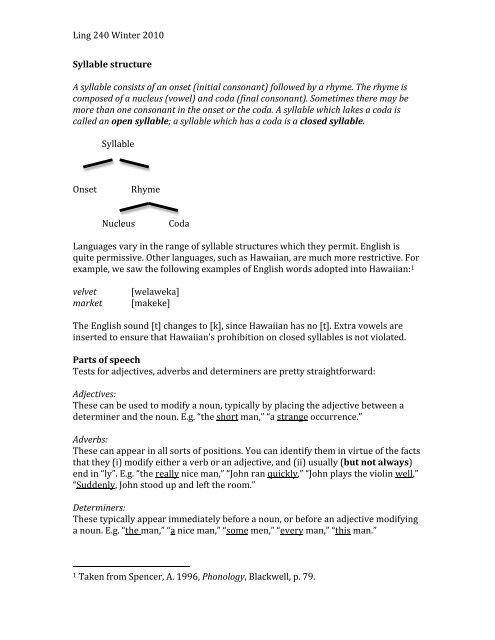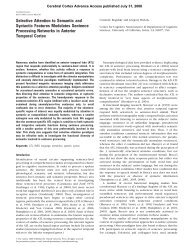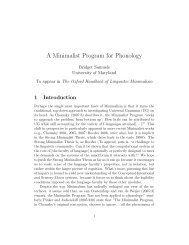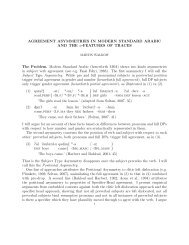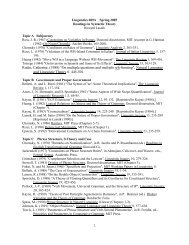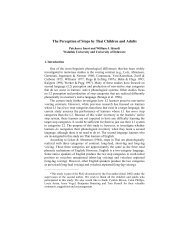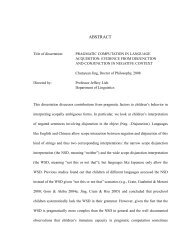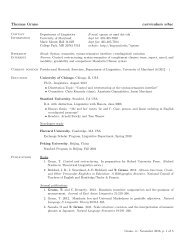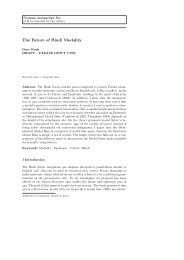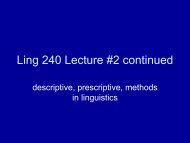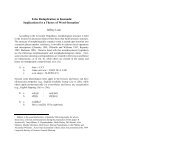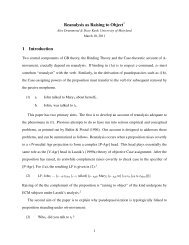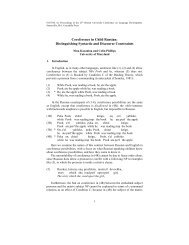Syllable structure and parts of speech
Syllable structure and parts of speech
Syllable structure and parts of speech
Create successful ePaper yourself
Turn your PDF publications into a flip-book with our unique Google optimized e-Paper software.
Ling 240 Winter 2010 <br />
<strong>Syllable</strong> <strong>structure</strong> <br />
<br />
A syllable consists <strong>of</strong> an onset (initial consonant) followed by a rhyme. The rhyme is <br />
composed <strong>of</strong> a nucleus (vowel) <strong>and</strong> coda (final consonant). Sometimes there may be <br />
more than one consonant in the onset or the coda. A syllable which lakes a coda is <br />
called an open syllable; a syllable which has a coda is a closed syllable. <br />
<br />
<strong>Syllable</strong> <br />
<br />
<br />
<br />
Onset Rhyme <br />
<br />
<br />
Nucleus Coda <br />
<br />
Languages vary in the range <strong>of</strong> syllable <strong>structure</strong>s which they permit. English is <br />
quite permissive. Other languages, such as Hawaiian, are much more restrictive. For <br />
example, we saw the following examples <strong>of</strong> English words adopted into Hawaiian: 1 <br />
<br />
velvet [welaweka] <br />
market [makeke] <br />
<br />
The English sound [t] changes to [k], since Hawaiian has no [t]. Extra vowels are <br />
inserted to ensure that Hawaiian’s prohibition on closed syllables is not violated. <br />
<br />
Parts <strong>of</strong> <strong>speech</strong> <br />
Tests for adjectives, adverbs <strong>and</strong> determiners are pretty straightforward: <br />
<br />
Adjectives: <br />
These can be used to modify a noun, typically by placing the adjective between a <br />
determiner <strong>and</strong> the noun. E.g. “the short man,” “a strange occurrence.” <br />
<br />
Adverbs: <br />
These can appear in all sorts <strong>of</strong> positions. You can identify them in virtue <strong>of</strong> the facts <br />
that they (i) modify either a verb or an adjective, <strong>and</strong> (ii) usually (but not always) <br />
end in “ly”. E.g. “the really nice man,” “John ran quickly,” “John plays the violin well,” <br />
“Suddenly, John stood up <strong>and</strong> left the room.” <br />
<br />
Determiners: <br />
These typically appear immediately before a noun, or before an adjective modifying <br />
a noun. E.g. “the man,” “a nice man,” “some men,” “every man,” “this man.” <br />
<br />
<br />
1 Taken from Spencer, A. 1996, Phonology, Blackwell, p. 79.
Ling 240 Winter 2010 <br />
None <strong>of</strong> the above really differs from what traditional grammar has to say about <br />
adjectives, adverbs <strong>and</strong> determiners. However, our approach to nouns <strong>and</strong> verbs is <br />
quite different from the traditional approach. Instead <strong>of</strong> trying to define nouns <strong>and</strong> <br />
verbs in terms <strong>of</strong> meaning (e.g. saying that a noun refers to a “person, place or <br />
thing”), we will be using more precise syntactic tests for nounhood <strong>and</strong> verbhood. <br />
<br />
The basic principle is very simple. Nouns have some properties that verbs don’t, <strong>and</strong> <br />
verbs have some properties that nouns don’t. For example, verbs (in English) have <br />
tense, whereas nouns don’t have tense. English nouns have number <br />
(singular/plural), whereas verbs do not. 2 <br />
<br />
No one property will reliably identify all nouns or verbs; you need to look at two or <br />
three to be sure in your conclusion. For example, not all English nouns can be <br />
pluralized (“* soups”), <strong>and</strong> not all English verbs show obvious tense distinctions <br />
(e.g. “used” in “I used to do that” cannot be used in the present or future tenses). <br />
<br />
The following lists give some arbitrarily selected properties <strong>of</strong> nouns <strong>and</strong> verbs <br />
which you can use to identify a word as one <strong>of</strong> these two categories. These are in no <br />
way complete or definitive lists, but they should be sufficient for our purposes. <br />
<br />
Nouns: <br />
Singular/plural. <br />
Often (but not always) preceded by a determiner . <br />
Modfiable by adjectives. <br />
<br />
Verbs: <br />
Tense (past, present, future). <br />
Modifiable by adverbs. <br />
Can be replaced by shorth<strong>and</strong> forms like do/did, e.g. “John likes Mary <strong>and</strong> Bill does <br />
(= likes Mary) too.” <br />
<br />
2 This is confused slightly by the fact that English verbs do agree in number with the <br />
subject <strong>of</strong> a sentence. But this works quite differently from number on nouns. Verbs <br />
add a “‐s” ending in the present tense when the subject is singular, but <strong>of</strong> course the <br />
“‐s” ending on nouns indicates plurality.


